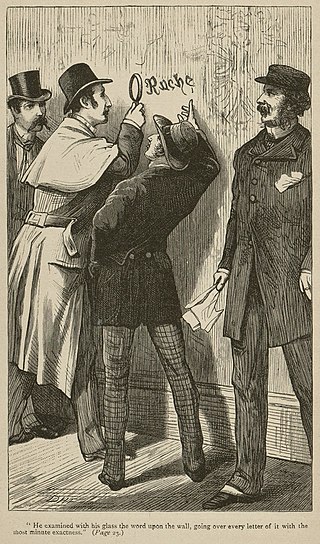Related Research Articles

The beagle is a breed of small scent hound, similar in appearance to the much larger foxhound. The beagle was developed primarily for hunting hare, known as beagling. Possessing a great sense of smell and superior tracking instincts, the beagle is the primary breed used as a detection dog for prohibited agricultural imports and foodstuffs in quarantine around the world. The beagle is intelligent and is a popular pet due to its size, good temper, and a lack of inherited health problems.

Fox hunting is an activity involving the tracking, chase and, if caught, the killing of a fox, traditionally a red fox, by trained foxhounds or other scent hounds. A group of unarmed followers, led by a "master of foxhounds", follow the hounds on foot or on horseback. In Australia, the term also refers to the hunting of foxes with firearms, similar to deer hunting.

Beagling is the hunting mainly of hares and also rabbits, by beagles by scent. A beagle pack is usually followed on foot, but in a few cases mounted. Beagling is often enjoyed by 'retired' fox hunters who have either sustained too many injuries or lost the agility to ride horseback, or who enjoy the outdoors and the camaraderie of the hunt. It is also traditionally a way for young men and women to learn how to handle hounds on a smaller scale before they go on to hunt with foxhounds.

The Hunt Saboteurs Association (HSA) is a United Kingdom organisation that uses hunt sabotage as a means of direct action to stop fox hunting. It was founded in 1963, with its first sabotage event occurring at the South Devon Foxhounds on the 26th of December, 1963.

Drag hunting or draghunting is a form of equestrian sport, where mounted riders hunt the trail of an artificially laid scent with hounds.

The Hunting Act 2004 is an Act of the Parliament of the United Kingdom which bans the hunting of most wild mammals with dogs in England and Wales, subject to some strictly limited exemptions; the Act does not cover the use of dogs in the process of flushing out an unidentified wild mammal, nor does it affect drag hunting, where hounds are trained to follow an artificial scent.

A red herring is something that misleads or distracts from a relevant or important question. It may be either a logical fallacy or a literary device that leads readers or audiences toward a false conclusion. A red herring may be used intentionally, as in mystery fiction or as part of rhetorical strategies, or may be used in argumentation inadvertently.
Legislation on hunting with dogs is in place in many countries around the world. Legislation may regulate, or in some cases prohibit the use of dogs to hunt or flush wild animal species.

The Berkeley Hunt is a foxhound pack in the west of England. Its country lies in the southern part of Gloucestershire, between Gloucester and Bristol.

The Fox and the Hound is a 1967 novel written by American novelist Daniel P. Mannix and illustrated by John Schoenherr. It follows the lives of Tod, a red fox raised by a human for the first year of his life, and Copper, a half-bloodhound dog owned by a local hunter, referred to as the Master. After Tod causes the death of the man's favorite hound, man and dog relentlessly hunt the fox, against the dual backdrops of a changing human world and Tod's normal life in hunting for food, seeking a mate, and defending his territory. As preparation for writing the novel, Mannix studied foxes, both tame and wild, a wide variety of hunting techniques, and the ways hounds appear to track foxes, seeking to ensure his characters acted realistically.
Hunting the clean boot is a term that has been used in Britain to refer to the use of packs of bloodhounds to follow a natural human scent trail.
Hound trailing, or hound racing, is a dog sport that uses specially bred hounds to race along an artificially laid scent trail over a cross country course.

The bloodhound is a large scent hound, originally bred for hunting deer, wild boar and, since the Middle Ages, for tracking people. Believed to be descended from hounds once kept at the Abbey of Saint-Hubert, Belgium, in French it is called, le chien de Saint-Hubert.

The Quorn Hunt, usually called the Quorn, established in 1696, is one of the world's oldest fox hunting packs and claims to be the United Kingdom's most famous hunt. Its country is mostly in Leicestershire, together with some smaller areas of Nottinghamshire and Derbyshire.
A limer, or lymer, was a kind of dog, a scenthound, used on a leash in medieval times to find large game before it was hunted down by the pack. It was sometimes known as a lyam hound/dog or lime-hound, from the Middle English word lyam, meaning 'leash'. The French cognate limier has sometimes been used for the dogs in English as well. The type is not to be confused with the bandog, which was also a dog controlled by a leash, typically a chain, but was a watchdog or guard dog.
Mink hunting is a country sport involving the hunting of American mink with scent hounds along the waterways which make up their habitat, in a manner similar to fox hunting. Mink hunting took place in the countryside in the UK and Ireland, but since 2005 traditional mink hunting has been banned in England and Wales.

The Warwickshire Hunt is an English fox hunting pack founded in 1791.

The Adelaide Hunt Club is an Australian fox hunting club founded in the 1840s.

The British Hound Sports Association (BHSA) is the governing body for all (hunting) hound sports associations in Great Britain. It is responsible for setting standards and rules which members and registered hunts are supposed to adhere to. A sister organisation, the Hound Sports Regulatory Authority (HSRA), is responsible for regulatory and disciplinary matters for members and member hunts, in accordance with rules set by the BHSA.
References
- ↑ "Call to ban controversial trail hunting on North Northamptonshire Council land". www.northantstelegraph.co.uk. Retrieved 10 July 2022.
- ↑ "Hunt ban forced through Commons". BBC News. 19 November 2004. Retrieved 22 February 2008.
- ↑ Griffin, Emma (2007). Blood Sport. Yale University Press.
- ↑ "Fox hunting worldwide". BBC News. 16 September 1999. Retrieved 5 October 2007.
- ↑ "Peterborough Council bans foxhunting". www.waronwildlife.co.uk. Retrieved 10 July 2022.
- ↑ "Trail Laying". www.huntingact.co.uk. Retrieved 10 July 2022.
- ↑ "What's The Difference Between Drag Hunting and Trail Hunting?". www.keeptheban.uk. Retrieved 10 July 2022.
- ↑ "What's The Difference Between Drag Hunting and Trail Hunting?". www.keeptheban.uk. Retrieved 10 July 2022.
- ↑ "What is Trail Hunting?". www.thehuntingoffice,org.uk. Retrieved 10 July 2022.
- ↑ "What is 'Trail' Hunting?". www.league.org.uk. Retrieved 10 July 2022.
- ↑ "What is trail hunting and is it legal?". www.itv.com. Retrieved 10 July 2022.
- ↑ "The impact of hunting with dogs on wildlife and conservation" (PDF). www.league.org.uk. Retrieved 10 July 2022.
- ↑ "Trail Hunting". www.league.org.uk. Retrieved 10 July 2022.
- ↑ "Trail hunting banned in Malvern Hills". www.birminghammail.co.uk. Retrieved 10 July 2022.
- ↑ "One of Britain's Biggest Landowners, Natural Resources Wales, Bans Trail Hunting". www.itv.com. Retrieved 10 July 2022.
- ↑ "National Trust to end fox 'trail' hunting on its land". www.independent.co.uk. Retrieved 10 July 2022.
- ↑ "Trail Hunting in the Nation's Forests". www.forestryengland.uk. Retrieved 10 July 2022.
- 1 2 3 Nicholas Goddard and John Martin, "Drag hunting", Encyclopedia of traditional British rural sports, Tony Collins, John Martin and Wray Vamplew (eds), Routledge, Abingdon, 2005, ISBN 0-415-35224-X, p104.